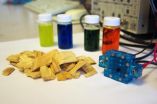(Press-News.org) Two types of regional anesthesia do not make patients more prone to falls in the first days after having knee replacement surgery as some have previously suggested, according to a study based on nearly 200,000 patient records in the March issue of Anesthesiology.
Regional forms of anesthesia – spinal or epidural (neuraxial) anesthesia and peripheral nerve blocks (PNB) – which only numb the area of the body that requires surgery, provide better pain control and faster rehabilitation and fewer complications than general anesthesia, research shows. But some surgeons avoid using them due to concerns regional anesthesia may cause motor weakness, making patients more likely to fall when they are walking in the first days after knee replacement surgery.
"We found that not only do these types of anesthesia not increase the risk of falls, but also spinal or epidural anesthesia may even decrease the risk compared to general anesthesia," said Stavros G. Memtsoudis, M.D., Ph.D., professor of anesthesiology and public health and director of critical care services, Hospital for Special Surgery, New York, and lead author. "This work suggests that fear of in-hospital falls is not a reason to avoid regional anesthesia for orthopedic surgery."
Researchers analyzed the types of anesthesia used in 191,570 knee replacement surgeries in the Premier Perspective database: 76.2 percent of patients had general anesthesia, 10.9 percent had spinal or epidural anesthesia, and 12.9 percent had a combination of neuraxial and general anesthesia. In addition, 12.1 percent of all patients had PNB. Researchers then analyzed the type of anesthesia used for those who suffered a fall in the hospital. Of patients who had general anesthesia, 1.62 percent fell, compared to 1.3 percent of those who had neuraxial anesthesia and 1.5 percent who had general and neuraxial anesthesia. Patients who also received a PNB had a fall rate of 1.58 percent.
When patients fall during recovery, they are more likely to have worse outcomes, including more heart and lung problems and higher rates of death within 30 days of surgery. Spinal or epidural anesthesia and PNB are used far less often than general anesthesia because of concern that regional forms of anesthesia – particularly PNB – may increase muscle weakness and make patients more prone to falls. However, there has never been a large study based on real-world practices to determine if that is true.
"In this study using data from a wide range of hospital settings we found this concern seems unfounded, especially because hospitals and physicians performing these procedures use fall-prevention programs and are able to reduce the impact of other factors shown to increase fall risk, such as higher narcotic use," said Dr. Memtsoudis.
INFORMATION:
The American Society of Anesthesiologists
Founded in 1905, the American Society of Anesthesiologists (ASA) is an educational, research and scientific society with more than 52,000 members organized to raise and maintain the standards of the medical practice of anesthesiology. ASA is committed to ensuring physician anesthesiologists evaluate and supervise the medical care of patients before, during and after surgery to provide the highest quality and safest care every patient deserves.
For more information on the field of anesthesiology, visit the American Society of Anesthesiologists online at asahq.org. To learn more about the role physician anesthesiologists play in ensuring patient safety, visit asahq.org/WhenSecondsCount. Join the social conversation today. Like ASA on Facebook, follow ASALifeline on Twitter.
Chance of falling after knee replacement not increased by regional anesthesia
Research suggests spinal and epidural anesthesia, peripheral nerve blocks safe to use
2014-02-18
ELSE PRESS RELEASES FROM THIS DATE:
Obese patients who feel judged by doctors are less likely to shed pounds, study shows
2014-02-18
Overweight and obese people who feel their physicians are judgmental of their size are more likely to try to shed pounds but are less likely to succeed, according to results of a study by Johns Hopkins researchers.
The findings, reported online last week in the journal Preventive Medicine, suggest that primary care doctors should lose the negative attitudes their patients can sense if the goal is to get patients with obesity to lose 10 percent or more of their body weight — an amount typically large enough to reduce blood pressure, cholesterol and diabetes risk.
"Negative ...
Medicaid's 'tube-tying' polices create roadblocks for low-income women
2014-02-18
PRINCETON, N.J.—Tubal ligation – commonly referred to as having one's "tubes tied" – is widely used to prevent unintended pregnancies. However, current Medicaid policies create roadblocks for low-income women trying to obtain the procedure, according to a review written by researchers at Princeton University's Woodrow Wilson School and other U.S. institutions.
Under a Medicaid rule enacted in 1978, women must currently wait 30 days after signing a written consent form to obtain a tubal ligation. This requirement is prohibitive for many women who want to receive the ...
Can marijuana protect the immune system against HIV and slow disease progression?
2014-02-18
New Rochelle, NY, February 18, 2014—New evidence that chronic intake of THC, the primary psychoactive ingredient in marijuana, can protect critical immune tissue in the gut from the damaging effects of HIV infection is reported in AIDS Research and Human Retroviruses, a peer-reviewed journal from Mary Ann Liebert, Inc., publishers. The article is available free on the AIDS Research and Human Retroviruses website at http://www.liebertpub.com/aid.
Patricia Molina and coauthors from Louisiana State University Health Sciences Center, New Orleans, report that chronic THC administration ...
Solar-induced hybrid fuel cell produces electricity directly from biomass
2014-02-18
Although low temperature fuel cells powered by methanol or hydrogen have been well studied, existing low temperature fuel cell technologies cannot directly use biomass as a fuel because of the lack of an effective catalyst system for polymeric materials.
Now, researchers at the Georgia Institute of Technology have developed a new type of low-temperature fuel cell that directly converts biomass to electricity with assistance from a catalyst activated by solar or thermal energy. The hybrid fuel cell can use a wide variety of biomass sources, including starch, cellulose, ...
Quest for jellyfish robot leads to discovery of bending rules for animal wing, fin tips
2014-02-18
WOODS HOLE, Mass. —A Navy-sponsored project to design a biologically inspired, swimming jellyfish robot has led scientists to the surprising discovery of common bending rules for the tips of wings, fins, flukes, mollusk feet, and other propulsors across a broad range of animal species.
The study, led by John H. Costello of Providence College and the Marine Biological Laboratory (MBL) in Woods Hole, where he is a visiting scientist, is published this week in Nature Communications.
By studying videos of 59 different animals—from fruit flies to humpback whales—propelling ...
Single chip device to provide real-time 3-D images from inside the heart, blood vessels
2014-02-18
Researchers have developed the technology for a catheter-based device that would provide forward-looking, real-time, three-dimensional imaging from inside the heart, coronary arteries and peripheral blood vessels. With its volumetric imaging, the new device could better guide surgeons working in the heart, and potentially allow more of patients' clogged arteries to be cleared without major surgery.
The device integrates ultrasound transducers with processing electronics on a single 1.4 millimeter silicon chip. On-chip processing of signals allows data from more than a ...
'Legal highs,' PMMA and zombie panic
2014-02-18
Recent deaths in both Canada and the UK linked to PMA/PMMA in ecstasy pills has brought public scrutiny to this little known drug. With Canadian producing most of the ecstasy in the North American market, this timely paper (Ecstasy, legal highs and designer drug use: A Canadian perspective) published this week in Drug Science Policy and Law looks at trends in ecstasy adulteration, the facts around PMA/PMMA-linked deaths and explores alternatives to the endless banning of new drugs.
It finds:
In 2007, according to the Health Canada Drug Analysis Service, only 3% of seized ...
A stretchable highway for light
2014-02-18
WASHINGTON, Feb. 18, 2014—For futuristic applications like wearable body sensors and robotic skin, researchers need to ferry information along flexible routes. Electronics that bend and stretch have become possible in recent years, but similar work in the field of optics – communicating with light instead of electrons – has lagged behind. Particularly difficult to engineer have been optics that stretch, lengthening when someone wearing body sensors bends to tie their shoe, or when a robotic arm twists through a full range of motion.
Now a team of Belgian researchers reports ...
Georgia Tech study reveals copyright complexities, social norms in online media creation
2014-02-18
In the age of mashups, fan fiction and content sharing, online media creation has spurred new complexities in copyright, effectively turning the legal concept of "fair use" on its ear, according to a new study from Georgia Tech.
Research into fan fiction and other types of remix communities reveals many legal misconceptions persistent among different groups when applying copyrighted work to their own creations. The research also highlights online social norms – independent of actual law – that guide the use of copyrighted works in fan communities.
For the study, Georgia ...
Clemson researchers develop sticky nanoparticles to fight heart disease
2014-02-18
CLEMSON, S.C. — Clemson University researchers have developed nanoparticles that can deliver drugs targeting damaged arteries, a non-invasive method to fight heart disease.
Heart disease is the leading cause of death in the U.S., according to the Centers for Disease Control and Prevention. One of the standard ways to treat clogged and damaged arteries currently is to implant vascular stents, which hold the vessels open and release such drugs as paclitaxel.
The researchers, led by Clemson bioengineering professor Naren Vyavahare, hope their advanced nanoparticles could ...
LAST 30 PRESS RELEASES:
Fame itself may be critical factor in shortening singers’ lives
Daily coffee drinking may slow biological ageing of people with major mental illness
New highly efficient material turns motion into power – without toxic lead
The DEVILS in the details: New research reveals how the cosmic landscape impacts the galaxy lifecycle
After nearly 100 years, scientists may have detected dark matter
Gender imbalance hinders equitable environmental governance, say UN scientists
Six University of Tennessee faculty among world’s most highly cited researchers
A type of immune cell could hold a key to preventing scar tissue buildup in wounds
Mountains as water towers: New research highlights warming differences between high and low elevations
University of Tennessee secures $1 million NSF grant to build semiconductor workforce pipeline
Biochar shows powerful potential to build cleaner and more sustainable cities worldwide
UT Health San Antonio leads $4 million study on glucagon hormone’s role in diabetes, obesity
65-year-old framework challenged by modern research
AI tool helps visually impaired users ‘feel’ where objects are in real time
Collaborating minds think alike, processing information in similar ways in a shared task
Routine first trimester ultrasounds lead to earlier detection of fetal anomalies
Royal recognition for university’s dementia work
It’s a bird, it’s a drone, it’s both: AI tech monitors turkey behavior
Bormioli Luigi renews LionGlass deal with Penn State after successful trial run
Are developers prepared to control super-intelligent AI?
A step toward practical photonic quantum neural networks
Study identifies target for disease hyper progression after immunotherapy in kidney cancer
Concordia researchers identify key marker linking coronary artery disease to cognitive decline
HER2-targeted therapy shows promising results in rare bile duct cancers
Metabolic roots of memory loss
Clinical outcomes and in-hospital mortality rate following heart valve replacements at a tertiary-care hospital
Too sick to socialize: How the brain and immune system promote staying in bed
Seal milk more refined than breast milk
Veterans with cardiometabolic conditions face significant risk of dying during extreme heat events
How plants search for nutrients
[Press-News.org] Chance of falling after knee replacement not increased by regional anesthesiaResearch suggests spinal and epidural anesthesia, peripheral nerve blocks safe to use





